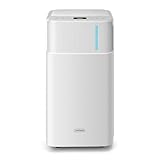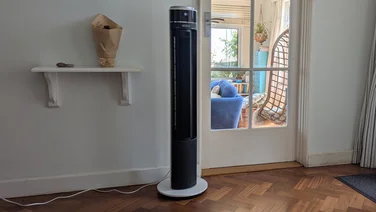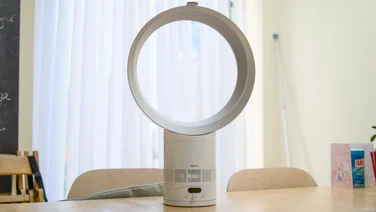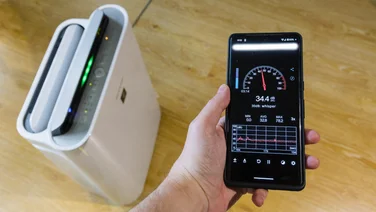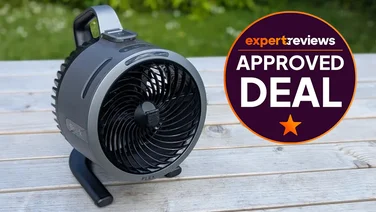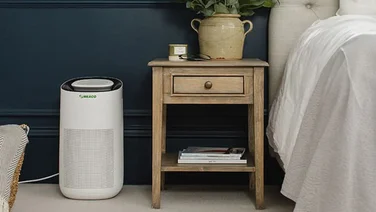To help us provide you with free impartial advice, we may earn a commission if you buy through links on our site. Learn more
- At Expert Reviews, we test dehumidifiers in real-world conditions. Running them in a damp-prone home, we use an air quality monitor and a hygrometer to measure at intervals of an hour how effectively they work at reducing the room’s relative humidity.
- We also test the dehumidifier’s ability to dry fresh laundry, as well as its power consumption and noise levels
- Our current favourite dehumidifier is the Meaco Arete Two 20l: it’s quiet yet powerful, with enough oomph for larger homes, and dries laundry with impressive efficiency.
- Read on for our full best dehumidifier roundup and buying guide
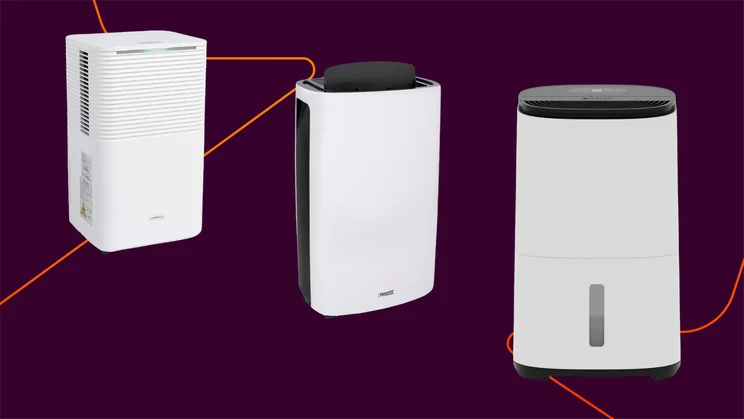
Our top dehumidifier, the Meaco Arete Two, is silent but mighty. It’s powerful enough for large homes and is immensely helpful when it comes to drying laundry. And on top of that, it’s energy efficient. It really shined in our tests, conducted in real-life conditions.
Expert Reviews has tested dozens of dehumidifiers, measuring their impact using humidity metres and air quality monitors, to provide you with a list of the best options for a variety of use cases and budgets.
You’ll find reviews of our recommendations below, along with an explanation of how we test dehumidifiers and a breakdown of the things to consider before buying one.
Best dehumidifiers: At a glance
| Best overall | Meaco Arete Two 20l | £300 | |
| Best value option for smaller homes | VonHaus Dehumidifier 12l | £115 | |
| Best for colder spaces | EcoAir DD1 Simple | £229 | |
| Best for low noise and drying laundry | Meaco DD8L Zambezi | £260 |
How we test dehumidifiers
We test dehumidifiers in real-world conditions in a damp-prone, three-bed detached home.
Initial testing takes place in the living room, with humidity readings taken before the device is switched on using its built-in humidity meter and an air quality monitor. A second humidity reading is taken after the device has been running for one hour and a third after two hours of operation.
We also measure noise levels across the dehumidifier’s various modes using a smartphone app sound meter from a distance of one metre. Every mode and feature available is tested comprehensively to ensure we have a thorough understanding of each aspect of the product’s performance.
Once these tests have been completed, we retest the dehumidifier in other areas of the house, including an upstairs landing and – with desiccant models – a free-standing concrete garage.
We also check how easy it is to empty the water tank, and how easy it is to clean and store the unit according to the manufacturer’s instructions.
The best dehumidifiers you can buy in 2025
1. Meaco Arete Two 20l: Best dehumidifier overall
Price when reviewed: £300 | Check price at Meaco

- Great for… large homes
- Not so great for… ease of use
The MeacoDry Arete One was once the best dehumidifier we had ever tested. Then its successor came along and made a series of notable improvements to keep Meaco at the top of this list.
On the outside, it looks largely unchanged from the Arete One. But on the inside, Meaco has switched out the AC motor with a DC motor, which makes it quieter and more efficient as well as faster at drying laundry: something that the Arete One struggled with. It’s also much more effective than the Arete One. During our tests, it brought humidity down from 76% to 67% in a 21.5°C living room in an hour, reaching 61% after another hour.
One of the only annoyances with the Arete Two is an ease-of-use issue. While the dehumidifier’s control panel is less complicated than it looks, some of Meaco’s app functions are not very intuitive and it can be difficult to find the scheduling features. This is a shame considering how easy to use the Arete One was.
Nevertheless, Meaco’s Arete Two dehumidifier is a strong evolution from its predecessor. Put simply, it’s the best all-round dehumidifier you can buy.
Read our Meaco Arete Two review for more information
Key specs – Dehumidifier type: Compressor; Tank size: 4.8l; Extraction rate: 20l per day; Maximum noise level: 50dB; Dimensions (WDH): 376 x 272 x 618mm; Weight: 15kg
2. ProBreeze PB-08: Best large-capacity dehumidifier
Price when reviewed: £180 | Check price at Amazon

- Great for… drying laundry, larger homes
- Not so great for… power consumption
While it can’t oust the Meaco Arete Two as the best dehumidifier for larger homes, the PB-08 runs it close. It’s also cheaper and has a larger tank, meaning it doesn’t have to be emptied as often. It reduced the humidity of my test room on a chilly winter’s day by 15% within two hours, which is a pretty impressive result, while the dedicated Laundry mode worked wonders on just-spun washing.
It’s not all good news, however. While I didn’t get near the stated 440W power consumption, peaks of 284W make this model more expensive to run than the Arete One. It’s also louder during general use, despite maximum output being higher on the Meaco.
Still, as long as you’re not planning to run it continuously throughout the colder months, the PB-08 is great value, giving you plenty of drying power and massive tank capacity at a surprisingly low price.
Key specs – Dehumidifier type: Compressor; Tank size: 5.5l; Extraction rate: 20 litres per day; Maximum noise level: 47dB; Dimensions (WDH): 320 x 200 x 580mm; Weight: 13.8kg
3. VonHaus Dehumidifier 12l: Best compact dehumidifier
Price when reviewed: £115 | Check price at Amazon

- Great for… small rooms, portability
- Not so great for… larger rooms, serious mould issues
This VonHaus dehumidifier is the least obtrusive and quietest option I’ve tested, producing around 39dB at its highest fan setting. It can be moved around the house without much bother and is easy to use too, with an automatic mode that can simply be left to work until your desired humidity level is reached.
Given its diminutive size, you might not expect much in terms of performance – and you’ll find the 2l tank needs emptying a few times a day if you’re working in a larger space. Yet the VonHaus surprised me in my test room by reducing the humidity levels from 80% to 70% within an hour and down to 65% within two hours.
You should buy something bigger for larger areas or if you have serious damp and mould. However, if you simply want to clear a lounge or bedroom of excess moisture, this compact champ will do the job.
Key specs – Dehumidifier type: Compressor; Tank size: 2l; Extraction rate: 12l per day; Maximum noise level: 39dB; Dimensions (WDH): 255 x 220 x 445mm; Weight: 9.5kg
4. De’Longhi AriaDry Multi: Best dehumidifier for small to mid-sized rooms
Price when reviewed: £268 | Check price at John Lewis

- Great for… small to medium-sized rooms, drying laundry
- Not so great for… noise levels
The AriaDry Multi isn’t quite as compact or quiet as the VonHaus Dehumidifier but is significantly more stylish and proved more effective during testing. It managed to reduce the humidity in a damp-prone living room by nearly 22% within two hours, a very impressive feat given its size.
It’s portable enough to be moved between rooms as required and has the VonHaus beaten when it comes to extraction rate, although this does mean you’ll need to empty the water tank more often. I found doing so very easy, however, as it pulls out neatly from the side and De’Longhi supplies an outlet and 1m plastic house for continuous draining, which is handy.
The AriaDry Multu dried laundry successfully in its dedicated mode too but I found it rather noisy, pumping out 50dB on all three of its dehumidifying settings, so it’s not one to leave on if you’re watching TV.
Key specs – Dehumidifier type: Compressor; Tank size: 2.1l; Extraction rate: 16l per day; Maximum noise level: 50dB; Dimensions (WDH): 332 x 220 x 508mm; Weight: 9kg
5. Princess 368120 Smart Dehumidifier: Best dehumidifier for remote control
Price when reviewed: £230 | Check price at Argos

- Great for… remote control and smart features
- Not so great for… speedy moisture removal, noise levels
This dehumidifier can be controlled entirely remotely from your smartphone using the Princess Home app. That’s incredibly useful if you’re out of the house and want to check humidity levels or simply want to schedule when the dehumidifier turns on and off during the week. If you’re not bothered about remote control, it’s still easy to operate through the touch controls on the top panel.
With an extraction rate of 20l per day, this model can easily handle larger spaces but was a little slower to remove moisture than the MeacoDry Arete One and ProBreeze – reducing humidity levels by 12% within two hours in my tests. It was, however, effective at drying clothes, doing so within six hours.
Sound output of between 46dB and 51dB means it’s not the most subtle operator going but it’s certainly the smartest I’ve tested and gets the job done in rooms of all different sizes.
Key specs – Dehumidifier type: Compressor; Tank size: 3.7l; Extraction rate: 20l per day; Maximum noise level: 51dB; Dimensions (WDH): 344 x 250 x 572mm; Weight: 13kg
6. EcoAir DD1 Simple: Best dehumidifier for colder spaces
Price when reviewed: £229 | Check price at Amazon

- Great for… portability, low-temperature settings
- Not so great for… power consumption, tank capacity
As a desiccant dehumidifier, the EcoAir DD1 works at lower temperatures than compressor options and thrives in colder spaces. It’s louder and consumes more power than dehumidifiers that use a refrigerated coil but can run more effectively over shorter periods, making it great for drying clothes or using in an outside office or garage. It’s relatively lightweight too, meaning it can be moved around easily.
Its 2l tank needed emptying more regularly than similarly specified models I’ve tested but there’s a 1m hose included if you need continuous draining into a sink or drain. And while there’s no timer, the laundry mode works brilliantly, the quiet and turbo functions are effective and the controls are simple and easy to use. Running costs will mount up if you leave the DD1 Simple running all day long, but it’s an excellent dehumidifier for situations where a refrigerant model just won’t work.
Key specs – Dehumidifier type: Desiccant; Tank size: 2l; Extraction rate: 7l per day; Maximum noise level: N/A; Dimensions (WDH): 290 x 175 x 485mm; Weight: 6kg
7. Meaco DD8L Zambezi: Best humidifier for use anywhere
Price when reviewed: £260 | Check price at Meaco

- Great for… portability, quiet operation, low-temperature settings
- Not so great for… power consumption, simplicity of controls
The Zambezi may be a desiccant dehumidifier but effectively reduces humidity both in your home and in colder external structures. It’s eminently portable and took the humidity in my test room down 21% within an hour and a further 5% within a second hour. It doesn’t skimp on features often omitted by desiccant models either. There’s a digital display, a daily run timer and a built-in ioniser, which helps remove airborne germs.
Noise levels were low during testing, with the unit outputting between 39dB and 44dB. What’s more, the Laundry+ mode did a fantastic job, drying my washing in under six hours. Power consumption can be high, peaking at over 600W at full power but this comes down to around 350W as it nears your required humidity level. The controls also take a bit of getting used to, but neither of these issues detract from the Zambezi’s ability to perform admirably anywhere.
Key specs – Dehumidifier type: Desiccant; Tank size: 3l; Extraction rate: 7.5l per day; Maximum noise level: 44dB; Dimensions (WDH): 360 x 200 x 550mm; Weight: 7.8kg
8. Swan ActivAir SH16810N: Best dehumidifier for ease of use
Price when reviewed: £200 | Check price at Freemans

- Great for… ease of use, minimalist design
- Not so great for… tank capacity, additional features
If you’re after a set-and-forget dehumidifier, this option from Swan is for you. There are no fancy modes and I found using it an absolute breeze; just set the desired humidity level, pick one of the two fan speeds and let it go to work. Beyond that, all you get is a shutdown timer and a “swing” function to make the air output oscillate upwards and downwards, which optimises air distribution and aids in the removal of moisture.
It’s not the quietest unit around, putting out between 45dB and 49dB while in use. I would also like to see a larger tank, as with a capacity of just 4l it’s going to need emptying at least once or twice a day in the colder, damper seasons. But the ActivAir has decent dehumidifying power – levels in my test room were reduced by 18% within two hours – and it’s well-designed and more affordable than a lot of the competition.
Key specs – Dehumidifier type: Compressor; Tank size: 4l; Extraction rate: 20l per day; Maximum noise level: 49dB; Dimensions (WDH): 342 x 251 x 561mm; Weight: 13.2kg
How to choose the best dehumidifier for you
What types of dehumidifier are there?
All dehumidifiers do the same basic job of removing excess moisture from the air. However, there are three different technologies that do all the hard work.
Compressor dehumidifiers work in much the same way as a fridge or freezer. They draw in air and cool it, condensing any moisture as it passes across a refrigerated coil. The water then drips off into a water tank below, while the air is reheated and released into the room. Compressor dehumidifiers can be noisy and may use more energy than other types, although new compressor technology and refrigerants are bringing improvements on both counts. They’re most efficient at warmer temperatures of 20°C and above, and your best bet if you need to remove lots of moisture from a larger space.
Peltier dehumidifiers also cool the air and condense the moisture content into water, but they do it using a cold heat-sink rather than a compressor. They’re not as effective as compressors, removing smaller amounts of water in a given time, but they’re quieter and more energy-efficient. Peltier dehumidifiers tend to be compact, lightweight units designed for smaller spaces.
Desiccant dehumidifiers don’t use a heat-sink or refrigerated coil to condense excess moisture, but instead draw the air across a wheel made from a desiccant material, which sucks the moisture out. As the wheel turns, moisture drips into the tank, while the damp patches are heated to dry them out again, warming up the air. Desiccant models tend to be expensive, but they’re generally quieter in operation than compressor dehumidifiers and more effective at lower temperatures. In fact, they will work in temperatures below 10°C, where compressor and Peltier units won’t work at all. If you need to dry out a loft or garage, you really need a dessicant model, but they can also be useful in a cold British winter for drying out your colder, damper rooms.
What size dehumidifier do I need?
It all depends on how much space you need to dehumidify. Dehumidifiers are often rated in terms of their extraction rate: how much water they can remove from the air in a single day. This is separate from their water tank capacity, which covers how much water they can store before you need to empty them out.
An extraction rate of around five to ten litres per day is fine if you’re dehumidifying a small to medium-sized room in an average UK home, but if you want to dry out larger rooms where you spend more time, you might want to go up to ten litres and beyond. Push that further to 15, 18 or 20 litres and you can dehumidify large rooms or even a flat, terraced house or a floor of a detached house or semi.
If you’re only planning to dehumidify occasionally – for a few hours here or there in a kitchen or bathroom, for instance – you can get away with a mini-dehumidifier with an extraction rate of less than one litre. It will be cheap to buy, cheap to run and perfectly effective. The same applies if you’re trying to fight damp or mould in a smaller area, such as a wardrobe, utility room or box bedroom.
If you’re pulling out 15 to 20 litres per day, the dehumidifier needs to have a tank with the capacity to handle it or you will be emptying it out every few hours. Three litres is the absolute minimum, while five or six litres will give you a bit less emptying to do.
Is there anything else worth looking out for?
Dehumidifiers don’t have to be noisy, and there are some good near-silent options. They will work discreetly in your home without interfering with your sleep or work, so a quiet mode or eco mode is well worth any extra, particularly if it will save you some cash in running costs.
Laundry modes are another great feature. Wet laundry drying on a rack or radiator is one of the most common causes of excess moisture in the winter months, and models with a specific laundry setting are designed to suck the water out of your drying clothes at a faster rate and prevent it from adding to the room’s humidity. They might even create airflow across a drying rack. Your clothes should dry quicker, too, making this a more eco-conscious alternative to slinging them into a tumble dryer.
How much do dehumidifiers cost to run?
This varies according to the design, size and extraction rate. Generally speaking, desiccant dehumidifiers use more energy per hour than a compressor model, but can also work more effectively at removing moisture, which means costs tend to even out.
However, it’s worth looking out for newer and more energy-efficient designs. For example, Meaco’s MeacoDry Arete Two 20l costs around £0.05 per hour to run, based on an electricity rate of 24.5p per kWh, while some models will cost significantly more at the same rate. Use your dehumidifier daily for a couple of hours and the difference soon mounts up.

